I just re-did my bilge pump configuration on Mariah for the third time. I keep playing with ways to handle the forward or “mast” bilge, which constantly overfills with water during the Seattle winter.
The layout of my 32-3 bilges, as I inherited the boat, was as follows: 4 removable bilge covers; a ¾” hose running to each of bilges #1 and #2; and a 1-1/2” hose running to bilge #3. The first two bilges held Rule submersible pumps, and the third housed the intake for the Whale-Gusher cockpit pump.
 Bilge Layout
Bilge Layout
The 4th bilge section is both too shallow and too sloped to hold a pump—any water in this bilge immediately flows under the TAFG into bilge #3. Further, due to the limber holes cut at the bottom of every section, any time there was more than about ¼” of water in any bilge, water migrated under the TAFG to all the other bilge sections. There were pluses and minuses to this: Advantage; a pump in any bilge section could drain the entire bilge. Disadvantage; I could never trap-and-pump water in any one bilge section—when one bilge section got wet, they all got wet.
My two main issues with the as-inherited system were this: (1) Both the Rule submersibles needed the Main DC panel to be energized to work--the first through the 3-way switch in the head, and the second through the main DC panel Bilge Pump breaker/switch. And, (2) every time it rained, water from the mast migrated from bilge #1 under the TAFG to all the other bilges.
Fix #1 was to install a “hot-wired” switch and pump that I could leave on all the time without powering the main DC panel. I posted about that here. I put this new system in bilge #3, but I had to steal one of the ¾” hoses from the forward bilges to plumb it.
Fix #2 was to “seal off” bilge #1 so it would hold water rather than constantly leak it under the TAFG. Since I was down to only one forward bilge hose, I removed the old pump from Bilge #1, raised the limber holes (twice) and hoped I could manage to hand-pump the bilge weekly before it overflowed.
Progression of bilge #1:
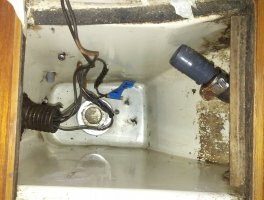 Original hose and wiring (to 3-way switch in lav)
Original hose and wiring (to 3-way switch in lav)
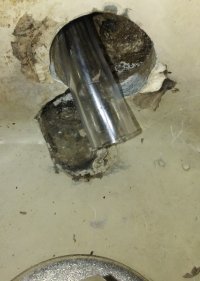 Original limber hole and drain hose (from shower pan) at bottom of bilge
Original limber hole and drain hose (from shower pan) at bottom of bilge
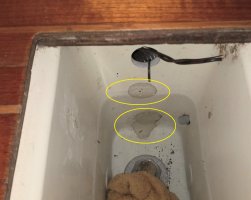 Raised limber holes to trap water, bilge hose removed
Raised limber holes to trap water, bilge hose removed
Turns out I couldn’t. With more than about 2” of rainfall, water from the mast reached the raised limber hole(s) (especially when windy and the boat was horsing around on the buoy) By the way, since January, we’ve had about 5 periods where we’ve had 2” of rain in 3 days or less in Seattle.
So ultimately, I would have to put a pump back in bilge #1. Problem was, I was now out of bilge hoses, and didn’t have access below my cabin sole to run another one through the TAFG. And, I didn’t want to remove the panel-powered pump from bilge#2--during my recent PSS shaft seal failure, that second pump was what gave me the capacity to pump out the bilges.
I’ve heard of people adding T-connections to through-hulls, but I needed a T- or Y-type valve on the inlet side, to let two pumps share a single outlet hose. I looked for a full-port ¾” Y-valve and was never able to find one. The non-full-port valves usually have a much smaller port diameter than the hose size. The best I could find was this (from Amazon):
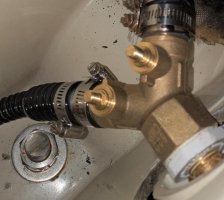 1"Fpt x 3/4" Mpt 3-Way Brass Ball Valve
1"Fpt x 3/4" Mpt 3-Way Brass Ball Valve
The non-valved end required a bushing to accept a ½”NPT nipple that fit into the ¾” hose. Each of the valved ends required a 1” bilge hose which slipped and clamped nicely over the 3/4" NPT threads. I slathered the ¾” bilge hose with a good amount of a clear sealant called Lexel (a polymer-based rubber), which held and sealed the smaller ¾” hose inside the 1” hose.
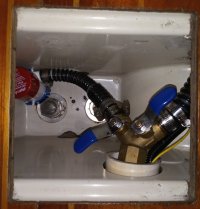
Having a new hose to serve bilge #1, I could finally added a hot-wired (and fused) switch and Rule 500 to manage rainwater from the mast.
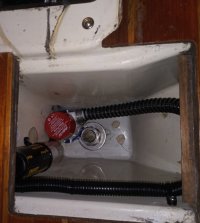
The general plan is to keep the valve open to bilge #1 all winter. This keeps all the other bilge and under-TAFG sections dry. During the dry season, I never get water in bilge #1 so I’ll switch the valve over to bilge #2. Sure, it might only take one hose clamp and two wires to relocate a bilge pump. But, when you really need that pump, it may be underwater, and if it is, time is likely critical.
Likely, someone’s gonna comment on the advantages of diaphragm pumps over the small centrifugals. I wouldn’t argue with them. I just can’t find a sensible place to install one on my 32-3. My bilge hoses don’t rise above the floor or TAFG until aft of the rudder tube. Then, they are only accessible for about 12” where they form the anti-siphon loop that connects to the through-hull. And, the need to run wiring to the stern doubles the overall wiring run length (which then starts at the battery box, runs forward to the switch in the bilge, then back to the stern).
If someone knows of a good place to mount a centrifugal in a 32-3, let me know. Until then, I’ve tried to optimize my 800/800/500gpm Rule pump setup.
The layout of my 32-3 bilges, as I inherited the boat, was as follows: 4 removable bilge covers; a ¾” hose running to each of bilges #1 and #2; and a 1-1/2” hose running to bilge #3. The first two bilges held Rule submersible pumps, and the third housed the intake for the Whale-Gusher cockpit pump.
 Bilge Layout
Bilge LayoutThe 4th bilge section is both too shallow and too sloped to hold a pump—any water in this bilge immediately flows under the TAFG into bilge #3. Further, due to the limber holes cut at the bottom of every section, any time there was more than about ¼” of water in any bilge, water migrated under the TAFG to all the other bilge sections. There were pluses and minuses to this: Advantage; a pump in any bilge section could drain the entire bilge. Disadvantage; I could never trap-and-pump water in any one bilge section—when one bilge section got wet, they all got wet.
My two main issues with the as-inherited system were this: (1) Both the Rule submersibles needed the Main DC panel to be energized to work--the first through the 3-way switch in the head, and the second through the main DC panel Bilge Pump breaker/switch. And, (2) every time it rained, water from the mast migrated from bilge #1 under the TAFG to all the other bilges.
Fix #1 was to install a “hot-wired” switch and pump that I could leave on all the time without powering the main DC panel. I posted about that here. I put this new system in bilge #3, but I had to steal one of the ¾” hoses from the forward bilges to plumb it.
Fix #2 was to “seal off” bilge #1 so it would hold water rather than constantly leak it under the TAFG. Since I was down to only one forward bilge hose, I removed the old pump from Bilge #1, raised the limber holes (twice) and hoped I could manage to hand-pump the bilge weekly before it overflowed.
Progression of bilge #1:
 Original hose and wiring (to 3-way switch in lav)
Original hose and wiring (to 3-way switch in lav) Original limber hole and drain hose (from shower pan) at bottom of bilge
Original limber hole and drain hose (from shower pan) at bottom of bilge Raised limber holes to trap water, bilge hose removed
Raised limber holes to trap water, bilge hose removedTurns out I couldn’t. With more than about 2” of rainfall, water from the mast reached the raised limber hole(s) (especially when windy and the boat was horsing around on the buoy) By the way, since January, we’ve had about 5 periods where we’ve had 2” of rain in 3 days or less in Seattle.
So ultimately, I would have to put a pump back in bilge #1. Problem was, I was now out of bilge hoses, and didn’t have access below my cabin sole to run another one through the TAFG. And, I didn’t want to remove the panel-powered pump from bilge#2--during my recent PSS shaft seal failure, that second pump was what gave me the capacity to pump out the bilges.
I’ve heard of people adding T-connections to through-hulls, but I needed a T- or Y-type valve on the inlet side, to let two pumps share a single outlet hose. I looked for a full-port ¾” Y-valve and was never able to find one. The non-full-port valves usually have a much smaller port diameter than the hose size. The best I could find was this (from Amazon):
 1"Fpt x 3/4" Mpt 3-Way Brass Ball Valve
1"Fpt x 3/4" Mpt 3-Way Brass Ball ValveThe non-valved end required a bushing to accept a ½”NPT nipple that fit into the ¾” hose. Each of the valved ends required a 1” bilge hose which slipped and clamped nicely over the 3/4" NPT threads. I slathered the ¾” bilge hose with a good amount of a clear sealant called Lexel (a polymer-based rubber), which held and sealed the smaller ¾” hose inside the 1” hose.

Having a new hose to serve bilge #1, I could finally added a hot-wired (and fused) switch and Rule 500 to manage rainwater from the mast.

The general plan is to keep the valve open to bilge #1 all winter. This keeps all the other bilge and under-TAFG sections dry. During the dry season, I never get water in bilge #1 so I’ll switch the valve over to bilge #2. Sure, it might only take one hose clamp and two wires to relocate a bilge pump. But, when you really need that pump, it may be underwater, and if it is, time is likely critical.
Likely, someone’s gonna comment on the advantages of diaphragm pumps over the small centrifugals. I wouldn’t argue with them. I just can’t find a sensible place to install one on my 32-3. My bilge hoses don’t rise above the floor or TAFG until aft of the rudder tube. Then, they are only accessible for about 12” where they form the anti-siphon loop that connects to the through-hull. And, the need to run wiring to the stern doubles the overall wiring run length (which then starts at the battery box, runs forward to the switch in the bilge, then back to the stern).
If someone knows of a good place to mount a centrifugal in a 32-3, let me know. Until then, I’ve tried to optimize my 800/800/500gpm Rule pump setup.
